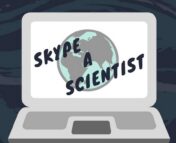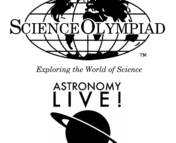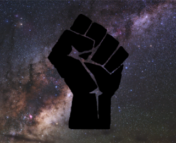This post is part of our series meant to showcase the various types of outreach activities you can do as a graduate student, as an undergraduate, or as an astronomer at any stage of your career! In each post, we’ll focus on one national organization and one local group — but today, we’re doing something a bit different, looking at three different local planetaria, hopefully inspiring you to visit or volunteer with one near you!
| Planetarium | Cost | Show information |
| WVU | Free public shows | Every other Friday evening |
| UCLA | Free public shows and free private shows for school groups (upon request) | Wednesday evenings during the school year |
| Sac State | General admission $5; free for Sac State students and children under 12 years | One or two weekends per month (details on website) |
WVU Planetarium (by Evan Lewis)
Location: White Hall on WVU campus: 135 Willey Street, Morgantown, WV 26506
Shows: Free public shows every other Friday, 7 and 8 PM
Contact Info: website, facebook, twitter
The WVU Planetarium is an on-campus planetarium on the roof of White Hall, home to WVU’s Department of Physics and Astronomy. The planetarium operations and shows are run by graduate students, and they offer FREE public shows every other Friday evening.
Each show begins with a tour of the night sky that evening, projected onto our full dome. Following the introduction, we play one of our many movies, ranging from 15-minute videos for young kids to longer movies on more in-depth astronomy topics. The planetarium also offers shows on other scientific topics, like supervolcanoes, Earth’s dynamic climate, and astronomy history. Guest presenters also come in to give presentations on their research, and cutting-edge discoveries in astronomy.
After the show, the audience is invited to look around the many displays inside the planetarium, including some telescopes from the first WVU observatory, and a flown tire from NASA that was used on the Columbia space shuttle during the STS-76 mission in 1996. We also display some tactile astronomy exhibits, which showcase constellations on a 3D printed surface so that blind audiences can appreciate them. On clear nights, the undergraduate Astronomy Club staffs the observatory, and the audience can use the 14” Celestron telescope to look at the night sky.
During the pandemic, the planetarium pivoted to virtual shows over Zoom, using the free Stellarium web app. While some of our standard planetarium movies were made available for online streaming, we also augmented our usual show rotation with presentations from WVU grad students, postdocs, and faculty. The planetarium also collaborated with other organizations, hosting talks and activities put on by the West Virginia Science Public Outreach Team as well as other local organizations.
The planetarium also offers free field trips to local schools and other educational groups. If you’re in the area and looking for some free astronomy content, check out the planetarium! Be sure to make a reservation before the show. You can also keep up to date with the planetarium by subscribing to our free quarterly newsletter!
UCLA Planetarium (by Briley Lewis)
Location: UCLA Math Sciences (8th Floor), 405 Hilgard Ave, Los Angeles, CA 90095
Shows: Free public shows every Wednesday during the school year, free private shows for educational/school groups by request, plus some recorded shows on YouTube
Contact Info: https://www.astro.ucla.edu/planetarium/ or follow us on Facebook and Twitter
The UCLA Planetarium is an on-campus planetarium open to the public, with a traditional star projector (pictured above). It’s entirely run by graduate students, and the presentations are given by all members of the UCLA astronomy, physics, and planetary science community, from undergrads to postdocs and even occasionally faculty.
Each week during the school year, we organize a show open to the general public on Wednesday evenings, where the presenter gives a short 30 minute presentation on some fun astronomy topic, followed by a night sky show with the projector. After the planetarium show, members of UCLA’s Undergrad Astronomy Society hold telescope viewings to demonstrate that even in Los Angeles we can observe the night sky. We also work with local school groups to organize shows for field trips, and for UCLA’s huge yearly outreach event, Exploring Your Universe. During the pandemic, we pivoted to host virtual shows using Stellarium on YouTube Live, all of which are recorded and still available for viewing on our YouTube channel. Our shows are always FREE to the public!
The UCLA Planetarium coordinators are also constantly innovating and creating new content to improve our shows, aiming to reflect the diversity of modern astronomy. In the past year, we held special events to celebrate Black History Month, Women’s History Month, and the JWST launch. We are also working on offering shows in multiple languages, particularly Spanish and ASL, to better serve the diverse community here in Los Angeles. And we have a few exciting new shows in the works, including an accessible planetarium show featuring 3D printed tactile images and sonification for blind audiences. We’re also collaborating with local Tongva community members and indigenous UCLA students to organize an indigenous astronomy show.
If you’re in the area, please do come stop by one of our shows! If you’d like to support our efforts financially, you can donate to the planetarium here. And if you happen to be a UCLA student in astronomy / physics / any related subject, please reach out to us if you’re interested in presenting!
Sacramento State Planetarium (by Pratik Gandhi)
Location: 6000 J St, Sacramento, CA 95819 (on the campus of California State University, Sacramento)
Shows: General admission is $5, while entry for Sac State students and children 12-and-under is free – see more at https://www.csus.edu/college/natural-sciences-mathematics/physics-astronomy/planetarium.html
Contact Info: website, twitter, facebook, and instagram
Disclaimer: this description was written based on an email interview conducted with Dr. Kyle Watters, the planetarium director.
The Sacramento State planetarium is an on-campus planetarium at CSU Sacramento (also referred to as “Sac State”), and serves a variety of purposes. For all of CSU Sacramento’s introductory astronomy courses, the planetarium serves as the primary lecture hall. Additionally, it is open throughout the week for field trips for K-12 students from the Greater Sacramento area, serving a variety of schools in different communities. Lastly, there are public planetarium shows every month for a general audience!
Sac State faculty member Dr. Kyle Watters is in charge of running the planetarium, and designs public shows using the Digistar software system. The monthly public shows usually consist of two parts – first, an interactive walkthrough of a different astronomy topic (like constellations or deep sky objects), and second, a professionally produced fulldome film (example here). All shows are conducted by a faculty member from the Physics & Astronomy department at CSU Sacramento, who volunteer on the planetarium team.
A major part of Sac State’s mission is to be the anchor university for the surrounding region, serving people of all ages and from a variety of backgrounds and communities. In order to further this mission, planetarium tickets are highly subsidized (see details below), and field trips for K-12 schools are run at no cost to the schools or the students. Physics and Astronomy students at Sac State often work as student assistants at the planetarium, and are in charge of leading and coordinating most field trips. To quote Dr. Watter, “We hope to inspire these young learners [K-12 students] coming in for field trips to pursue their own STEM dreams; maybe one day becoming Sac State students as well!”
Astrobite edited by: Maryum Sayeed
Featured image credit: Bishop Museum




